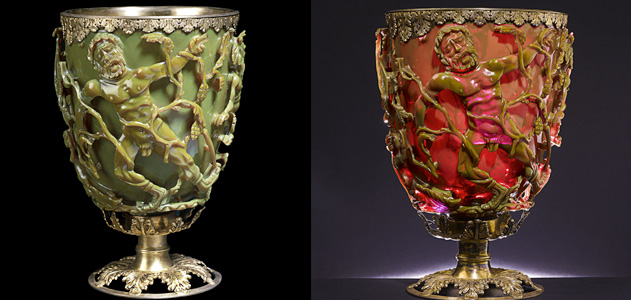Ancient Roman Nanotechnology improving the Future. Posted by Brittany Britanniae on Jan 21, 2014 in Roman culture

Lycurgus Cup Courtesy of The British Museum
Q:WHAT IS IT?
When asked about the above cup is made from, responders have answered “Ruby!” “Emerald!” “Gold!” Viewers of the Lycurgus Cup are often led astray as to the properties of this unique one-of-a-kind cup. Some even believe that the images represent two different cups or the same cup with red or green light shown upon it. WRONG!
A: The Lycurgus Cup is a Roman glass cage cup (or diatretum,). “A cage cup is made by blowing a thick glass blank. This was then cut and ground away until the figures were left in high relief. Sections of the figures are almost standing free and connected only by ‘bridges’ to the surface of the vessel.” It is also the only known complete example of dichroic glass. This means that the properties of the glass allow it to change color depending from which angle light is shown through. If lit from behind the glass turns red and green if lit from the front. You can watch it for yourself as the light changes in its case!
Q:WHO’S ON IT?
Well-from the images provide, there appears to be some man quite distraught at being held up or imprisoned by vines. But what does is mysterious moment mean?
A: The cup is known as the Lycurgus Cup due to the fact that the myth depicted on the vessel is one of Lycurgus’ fate. The entire story is retold at this page or in is this wonderful Art History video:
Safe to say, the cup depicts the horrible fate that beholds a mortal if they cross a god. “It has been speculated that the theme of this myth – the triumph of Dionysos over Lycurgus – might have been chosen to refer to a contemporary political event, the defeat of the emperor Licinius (reigned AD 308-24) by Constantine in AD 324. (A basic history may be found here.) Furthermore, it has also be suggested that the cup was used in the rite of Bacchus (Dionysus in Roman religion). In addition, Historia Augusta records the gift of two dichroic cups from Emperor Hadrian to his brother-in-law Servianus via a letter. Perhaps, this may have been one of them.
A:The British Museum acquired the cup in 1950’s, but it wasn’t until the 1990’s that they understood its properties. Researchers analyzed broken fragments of the cup and discovered that the Romans were nanotechnology pioneers!
(NANOTECHNOLOGY [as defined by Nano.gov] is science, engineering, and technology conducted at the nanoscale, which is about 1 to 100 nanometers. Nanoscience and nanotechnology are the study and application of extremely small things and can be used across all the other science fields, such as chemistry, biology, physics, materials science, and engineering.)
The glass effect of the Lycurgus Cups was achieved by making the glass with minutely ground gold and silver dust. The size of these particles of silver and gold are only about 50 nanometers across (less than one-thousandth the size of a grain of table salt) and required a transmission electron microscope to be seen.
SO WHAT DOES THIS MEAN….
It is highly impossible that Roman artists made these minute silver-gold alloy dust particles for this size of cup alone; therefore, these particles must have been added in large quantities to even large amounts of glass-melts. Therefore, there may have been other dichroic glass items made from the same glass-melt as the Lycurgus Cup. AND, this means that the Romans were the first to attempt and use nanotechnology in history! See the Nano Timeline here.
THE HYPOTHESIS
The color changing ability of the glass is due the size of metal flecks and how their electrons vibrate that alters their color. Gang Logan Liu, an engineer at the University of Illinois, conjectured that when various liquids filled the cup it would change the vibration of the electron and thus the color. Thus, he argued that the Lycurgus Cup’s phenomenon was very similar to a home pregnancy test, which uses a nano-based technology to turn a white line pink at the presence of HCG in urine. So, researchers began to formulate an experiment to test this hypothesis.
THE EXPERIMENT & RESULTS
Due to the fact that the Lycurgus Cup is a prized and unique artifact, researcher were unable to fill the cup itself. However, they created billions of wells (about the size of postage stamp) and sprayed them with a gold and silver nanoparticles. Thus, they created essential tiny version of the Lycurgus Cup. Then, they continued with the experiment by filling these wells with different types of liquids. The result was as predicted and the colors ranged from light green for water to red for oil. This “well” prototype was 100 times more sensitive to the differing salt levels of tested liquids than current sensor used for similar testing.
THE FUTURE
Liu is hopefully to see if the Roman’s nanotechnology of gold-silver alloy particles could have current science applications. This experiment proves that one day this technology may make its way to handheld devices for detecting pathogens in salvia or urine. This will allow for speedier drug testing, alcoholic testing, pregnancy tests, and even early detection with contagious and/or deadly diseases such as HIV, Ebola, Swine Flu, Bird Flu, and so on. However, it should be interesting to see what the costs for this new technology will be as it uses gold-silver alloy particles.

Build vocabulary, practice pronunciation, and more with Transparent Language Online. Available anytime, anywhere, on any device.
About the Author: Brittany Britanniae
Hello There! Please feel free to ask me anything about Latin Grammar, Syntax, or the Ancient World.



